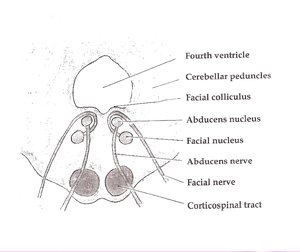| Medial pontine syndrome | |
|---|---|
 | |
| Pons. (Medial pontine syndrome affects structures at the bottom of the diagram: the corticospinal tract, abducens nerve, and occasionally the facial nerve. Medial lemniscus is also affected, but not pictured.) | |
| Specialty | Neurology |
Medial inferior pontine syndrome is a condition associated with a contralateral hemiplegia.[citation needed]"Medial inferior pontine syndrome" has been described as equivalent to Foville's syndrome.[1]
YouTube Encyclopedic
-
1/3Views:8 12224 4795 130
-
Medial Inferior Pontine Syndrome
-
Neurology | Pons Lesions
-
Medial Inferior Pontine Syndrome pics
Transcription
Presentation
Although medial pontine syndrome has many similarities to medial medullary syndrome, because it is located higher up the brainstem in the pons, it affects a different set of cranial nuclei.[citation needed]
| Structure affected | Presentation |
|---|---|
| Corticospinal tract | Contralateral spastic hemiparesis |
| Medial lemniscus | Contralateral PCML (aka DCML) pathway loss (tactile, vibration, and stereognosis) |
| Abducens nerve | Strabismus (ipsilateral lateral rectus muscle paralysis - the affected eye looks down and towards the nose). Abducens nerve lesion localizes the lesion to inferior pons. |
Depending upon the size of the infarct, it can also involve the facial nerve.
Cause

Medial pontine syndrome results from occlusion of paramedian branches of the basilar artery.[citation needed]
Diagnosis
Treatment
See also
- Alternating hemiplegia of childhood
- Lateral medullary syndrome
- Lateral pontine syndrome
- Medial medullary syndrome
- Weber's syndrome
References
- ^ Hubloue I, Laureys S, Michotte A (September 1996). "A rare case of diplopia: medial inferior pontine syndrome or Foville's syndrome". Eur J Emerg Med. 3 (3): 194–8. doi:10.1097/00063110-199609000-00011. PMID 9023501.
External links
